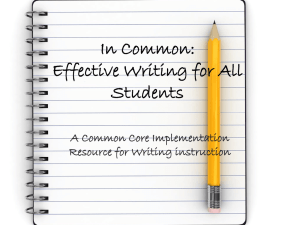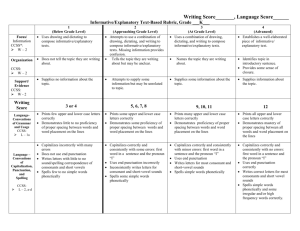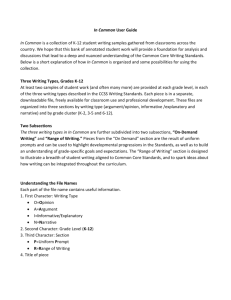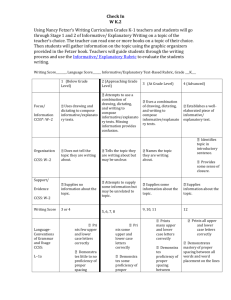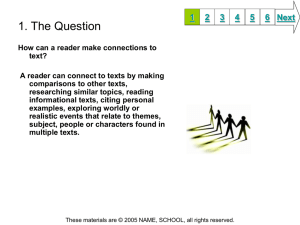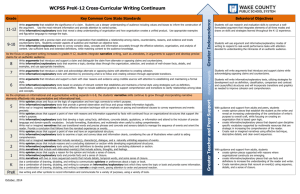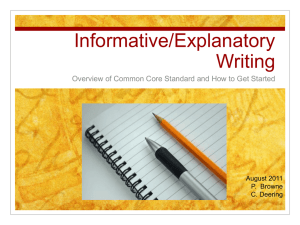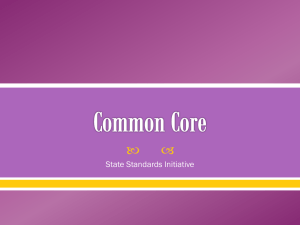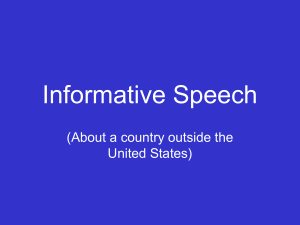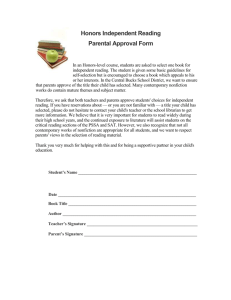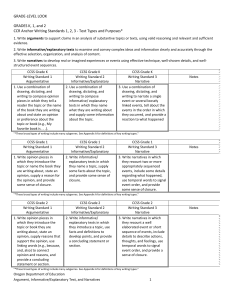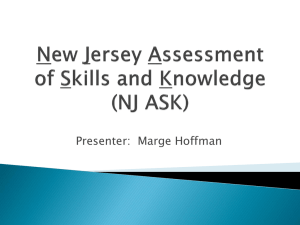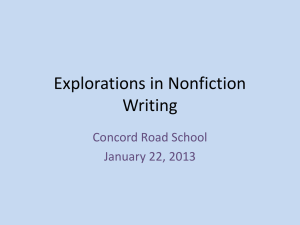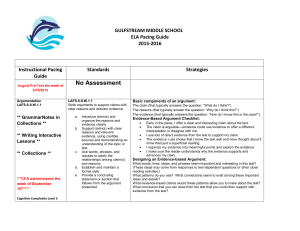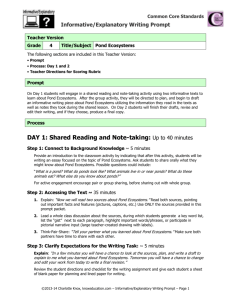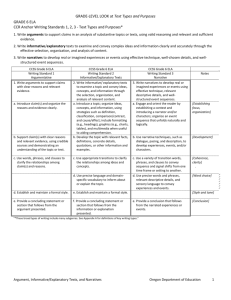Informative Explanatory - Second Grade Unit of Study Template
advertisement
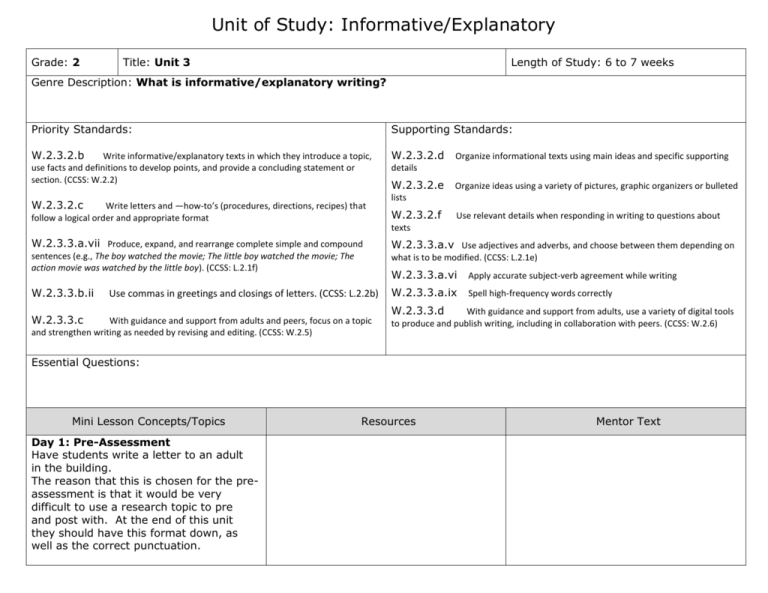
Unit of Study: Informative/Explanatory Grade: 2 Title: Unit 3 Length of Study: 6 to 7 weeks Genre Description: What is informative/explanatory writing? Priority Standards: Supporting Standards: W.2.3.2.b Write informative/explanatory texts in which they introduce a topic, use facts and definitions to develop points, and provide a concluding statement or section. (CCSS: W.2.2) W.2.3.2.d W.2.3.2.c lists Write letters and ―how-to’s (procedures, directions, recipes) that follow a logical order and appropriate format Organize informational texts using main ideas and specific supporting details W.2.3.2.e W.2.3.2.f Organize ideas using a variety of pictures, graphic organizers or bulleted Use relevant details when responding in writing to questions about texts W.2.3.3.a.vii Produce, expand, and rearrange complete simple and compound W.2.3.3.a.v Use adjectives and adverbs, and choose between them depending on sentences (e.g., The boy watched the movie; The little boy watched the movie; The action movie was watched by the little boy). (CCSS: L.2.1f) what is to be modified. (CCSS: L.2.1e) W.2.3.3.a.vi Apply accurate subject-verb agreement while writing W.2.3.3.b.ii W.2.3.3.a.ix Spell high-frequency words correctly Use commas in greetings and closings of letters. (CCSS: L.2.2b) W.2.3.3.c With guidance and support from adults and peers, focus on a topic and strengthen writing as needed by revising and editing. (CCSS: W.2.5) W.2.3.3.d With guidance and support from adults, use a variety of digital tools to produce and publish writing, including in collaboration with peers. (CCSS: W.2.6) Essential Questions: Mini Lesson Concepts/Topics Day 1: Pre-Assessment Have students write a letter to an adult in the building. The reason that this is chosen for the preassessment is that it would be very difficult to use a research topic to pre and post with. At the end of this unit they should have this format down, as well as the correct punctuation. Resources Mentor Text Unit of Study: Informative/Explanatory You could also choose to ask students to write a procedural piece to see where their skills are in terms of writing tasks, as well as the transition words and phrases needed to communicate the process being described. Letter Writing This portion of the unit should take one week. (standard w.2.3.2.c) Letter Format Introduce the main parts of a letter: heading, greeting, body, closing, and signature Possible activities: Write a letter to the class. Share a letter you have received. Compose a letter together. Students love to put letters into a mailbox. Bringing a real mailbox in for their letters is a fun thing for them to do. Since letters are a person form of writing This might be a good time to reinforce the Use of strong adjectives. If students are Familiar with using adverbs, this could be a Good time to review their use. (standard w.2.3.3.a.v) Punctuation in Letters Month-by-Month Trait- Based Writing (standard w.2.3.3.b.ii) Instruction by Maria P. Walther & Katherine Write a letter to the students without the A. Phillips (p.96) punctuation marks. Show a letter from a mentor text and point out the punctuation. Dear Peter Rabbit (Ada, 1994) Yours Truly, Goldilocks (Ada, 1998) With Love, Little Ren Hen (Ada, 2001) Click,Clack,Moo: Cows that Type (Cronin, 2000) Dear Mrs. LaRue: Letters From Obedience School (Teague, 2002) Unit of Study: Informative/Explanatory Procedures, Directions, and Recipes This section should take about two weeks. (standard w.2.3.2.c and w.2.3.2.e) Recipes Read books to students that contain a recipe. Talk about how they are broken into ingredients and the process. Month-by-Month Trait- Based Writing Chicks and Salsa (Reynolds,2005) Instruction by Maria P. Walther & Katherine The Giant Carrot (Peck, 1997) (p.110) Thunder Cake (Polacco, 1990) Have students write a recipe for a favorite sandwich. Have them share with a partner to let them see if their recipe makes sense. Commas in a series. Discuss how using a number of items can be written as bulleted items in a list or as a list in sentence form. Nonfiction Writing: Procedures and Reports (Lucy Calkins and Laurie Pessah) How to Write a How to Book Choose a topic Plan the steps on paper Sketch the steps Show what things will be needed Tell the steps in order If students are not doing well with transition words and phrases this would be a good time to review these skills. When these directions or procedures are edited, students should know that high frequency words are expected to be spelled correctly and subjects and verbs should agree. (standards w.2.3.3.d ,w.2.3.3.c , w.2.3.3.a.vi,and w.2.3.3.a.ix) http://jc-schools.net/write/transition.htm This page has a good list of transition words to use in a variety of writing pieces. Sentence Combining This is a good time to get students to focus on how they present the steps in their procedures. Sometimes putting Make It Real Strategies for Success with Informational Texts by Linda Hoyt (p.263) The book, Fluffy and Baron, by Laura Rankin is a good personal experience book that has a number of transition words and phrases. Unit of Study: Informative/Explanatory several steps together can help the flow. (standard w.2.3.3.a.vii) Informative Writing This should be four weeks in length. Two weeks should be Expert Books where students write about topics that they know about, and two weeks should be simple research activities. Students will do more advanced research during the Informative Revisit during third quarter. (standard w.2.3.2.b) Introduce Nonfiction Text Features Table of Contents, Titles, Captions, Headings, Subheadings, Bold Face Text, Glossary, Diagrams and Illustrations Students can be exposed to Indexes, Charts and Tables, but they will not be expected to use these until third grade. Some activities that you can try: After reading several books as a group, have students do scavenger hunts through NF books to look for the key features learned so far. Show a feature on the classroom document camera, and ask students to identify which feature it is. (This might be a fun team game.) Have students check out NF books from the library and then identify which features their book has. Students can create a collection of features by reading NF books and recording the features that their book had and also the purpose of that feature. Month-by-Month Trait- Based Writing All About Sharks (Arnosky, 2003) Instruction by Maria P. Walther & Katherine Bugs Are Insects (Rockwell, 2001) (p. 152 to 163) Mystery Fish: Secrets of the Coelacanth (Walker, 2006) http://it.pinellas.k12.fl.us/Teachers3/ What’s Up, What’s Down? gurianb/wus.html (Schaefer,2002) Many other books including any by Gail The Nonfiction Features Posters (Look for Gibbons can be helpful. Blue Ribbon) This is a GREAT set of Seymour Simon books are also great. Posters! Scholastic has a set called Science Vocabulary Readers that have most of Another source for Nonfiction Features these text features. Can be found at ReadingLady.com. www.readinglady.com Once there, you can search for Nonfiction Conventions Notebook. This is a Worksheet format where students can collect information about texts that they are reading or to help to record information from a text that they are using for their project. Month-by-Month Trait- Based Writing Instruction by Maria P. Walther & Katherine (p.155) This mini lesson shows how to go about collecting text features. Page Unit of Study: Informative/Explanatory 187 in the appendix shows a simple way to record their thoughts. They name the feature, draw and write what they see, and label the bottom of the page with the feature’s purpose. Introduce the idea of being an expert. A class poster can be made that shows a list of things that students think that they know a lot about. (This might help reluctant students see some things that they might not have thought about.) Start with a simple project. Have students choose an expert topic to write about. Tell them that they will need to choose 3 or 4 NF text features to use in this writing piece. Have students create simple books or posters that display their knowledge. Make It Real Strategies for Success with Informational Texts by Linda Hoyt (pages 289-314) The ideas in this section of the book discuss how students can present information on a poster in something called an investigation. The students write facts, create illustrations with captions, or diagrams with labels. They can create bold faced words and have an overall title for their work. The second project should be an actual research activity for the final two weeks. (standards w.2.3.2.b and w.2.3.2.d) Getting Started with Research What does it mean to do research? Possible Ideas Vote on a topic to research together. Use online resources and books from the library. Create a list of student questions prior to reading any information. (w.2.3.2.f) Create a poster with facts that are learned about the topic As a group use the facts collected America’s Choice -- Report (Grade 3) (note taking) Amazing Snakes “What do we already know about reports?” by Alexandra Parsons page 15 (table of contents) Whales “Using subheading to organize” page 92 by Deborah Hodge “Using boxes, photographs,illustrations, (labeling picture) Feathers for Lunch and/or diagrams to highlight specific by Lois Ehlert information” page 95 The Honey Makers by Gail Gibbons Nonfiction Craft Lessons, by Joann Sea Turtles Portalupi and Ralph Fletcher, by Gail Gibbons Note taking, pages 23-25 (making diagram) Bugs by Nancy Winslow Park Writing a table of contents, page 29 and Joan Richards Wright Unit of Study: Informative/Explanatory to start a sample project. Create a Table of Contents, choose the first item listed in the Table of Contents and create the first page of the book. Also, create a diagram with labels. This can be used as a reference for students when they get started on their own projects. This is a two to three day introduction to the process. Labeling a picture, page 31 Making a diagram, page 32 Nonfiction Mentor Texts, by Lynne Dorfman and Rose Cappelli, Building Content with Diagrams and Labels, pages 60-61 http://it.pinellas.k12.fl.us/Teachers3/ gurianb/index.html This site has a number of different resources. (Nonfiction Book Writing Paper) There is a 13 page teacher created form for a student book. It includes space for illustrations and page numbers. There is a glossary form and choices for diagrams. An index form is also included if that is wanted. There is also a teacher created book that has been made up as a sample that could be printed or projected for a preview. Students can record their facts on a planning sheet of some sort. They can make lists, a web, or use some other form that you have used in the past. Skills to Reinforce during this piece: Vary sentence beginnings Spelling high frequency words correctly Capitalization and punctuation Liven up the text with adjectives and adverbs A Place for Wonder Reading and Writing Nonfiction in the Primary Grades by Georgia Heard and Jennifer McDonough My Map Book by Sara Fanelli Stargazers by Gail Gibbons Surprising Sharks by Nicola Davies All About Frogs by Jim Arnosky From Seed to Sunflower by Dr. Gerald Legg Unit of Study: Informative/Explanatory This would also be a good time to review the idea of staying on topic. Each page that they write should be focused on one idea so that their Table of Contents and the pages of their book actually match up when they are finished. The next step would be to have students use this information to write their own pieces including the following NF text features: title, table of contents, subheadings, boldface text, diagrams and illustrations with captions, numbered pages, and a glossary. Students should choose three to four of these text features for this project. They will need to use all of them on their 3rd quarter project. On Demand Writing Prompts: You can do another letter at the end of this unit to check for retention of form and punctuation. Students could also write another procedural piece that demonstrates their ability to label the steps of a task. Common Formative Assessment Tasks: Checks for Understanding http://it.pinellas.k12.fl.us/Teachers3/ gurianb/index.html Show the sample project from this site to keep students on track.
